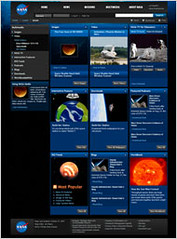NASA 2.0
 The NASA website has gone 2.0:
The NASA website has gone 2.0:
The National Aeronautics and Space Administration, concerned that people in the social networking generation have not shown enough interest in its work, has renovated its Web site to appeal more to the 18- to 25-year-old set.
The site, introduced over the weekend, has new blogs and widgets and more ways for people to view and manipulate content. A MyNASA feature has a “top playlist” that lets people watch clips of the space shuttle Discovery’s return to Florida or the California wildfires viewed from orbit.
The site, which has not had major overhaul since early 2003, still has information for policy makers and the media, but also more diversions. It is meant to compete with sites like Space.com (run by a company called Imaginova) and CNN, both of which have had more sophisticated presentations on space exploration.
“Younger folks look at the Web a different way,” said Brian Dunbar, Internet services manager for NASA. “They want to be able to pick and choose.” He estimates that the NASA site gets about a million unique visitors a month.
Many of the new features, like better feeds to users of aggregation sites like Digg, were made with young adults in mind.
NASA’s been providing great content for years now, but the addition of widgets and features like MyNASA will make the site even more user friendly, and allow users to stay abreast of favorite missions or research projects.
The more prominent use of blogs will also make highlighting NASA’s rich history even easier. For example, Shana Dale’s blog post reminds us that the first A in NASA stands for aeronautics:
NASA evolved from its predecessor, the National Advisory Committee for Aeronautics (NACA), which was formed by Congress in 1915 to undertake, promote, and institutionalize aeronautical research. During the past 50 years, NASA’s aeronautical research has provided breakthrough concepts, tools, and technologies to make air travel more safe, efficient, and environmentally friendly….
Today, NASA’s Aeronautics Research Mission Directorate builds upon this legacy and continues to develop new concepts, techniques, and technologies that will enable revolutionary capabilities for future aircraft as well as the airspace in which they fly. Much of our focus is on the Next Generation Air Transportation System, or "NextGen," a wide-ranging initiative involving six U.S. Government departments and agencies, as well as numerous industry and academic partners. The goal of NextGen is to transform our nation’s air transportation system so that, by 2025, it can handle the predicted two-to-three times increase in demand while maintaining safety and protecting the environment. NASA aeronautics programs conduct fundamental research for NextGen in areas of safety, air traffic management and the environment
There is a great link on the NASA aeronautics website where you can click directly on sections of a commercial plane to learn more about NASA’s contributions to aviation design and safety: NASA Aeronautics Research Onboard.